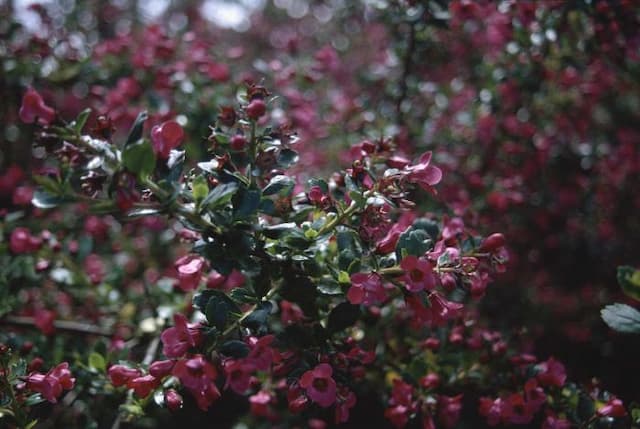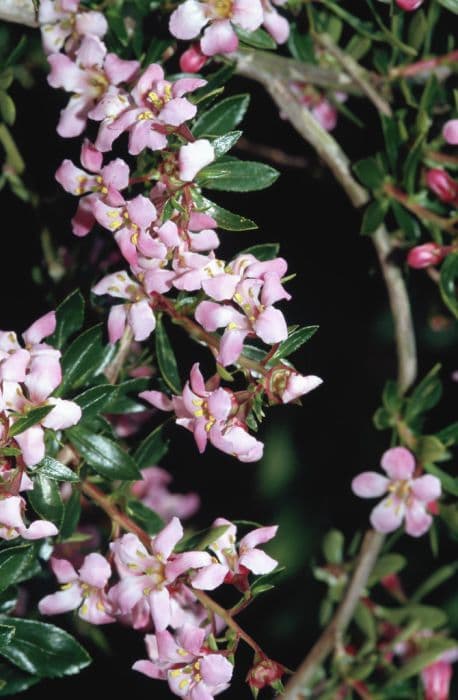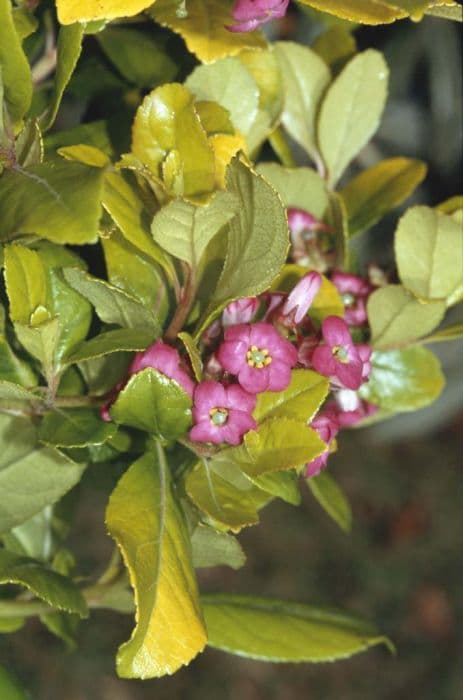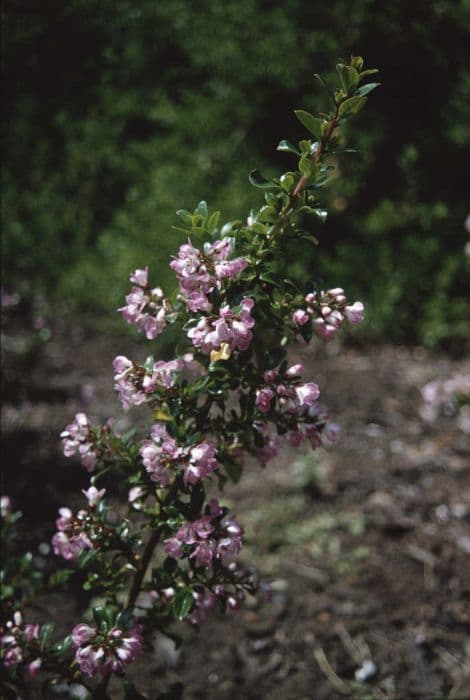Pink Elle Escallonia Escallonia laevis Pink Elle = 'Lades' (PBR)
![escallonia [Pink Elle]](/_next/image?url=https%3A%2F%2Fplants-admin.emdemapps.com%2Fimages%2Fplants%2F%2Fimages%2F604b630962bc2.png&w=3840&q=75)
ABOUT
The Escallonia Pink Elle is a compact evergreen shrub recognized for its lush, glossy, deep green leaves that provide a constant backdrop throughout the year. This plant is adorned with an abundance of small, bell-shaped flowers that exhibit a soft pink hue, adding a lovely pop of color to any garden space. The floriferous nature of Pink Elle results in an impressive and prolonged display that typically blossoms from early summer until the fall, bringing with it a profusion of floral interest for an extended period. The flowers are attractive to a variety of pollinators, including bees and butterflies, making it not only a visually appealing choice for gardeners but also beneficial for supporting local ecosystems. The overall appearance of Pink Elle is dense and bushy, creating an excellent choice for gardeners looking to add structure and year-round interest to their garden designs.
About this plant
 Names
NamesSynonyms
Pink Elle Escallonia, Laevis Pink Escallonia.
Common names
Escallonia laevis Pink Elle = 'Lades' (PBR).
 Toxicity
ToxicityTo humans
Escallonia is not known to be toxic to humans. However, as with any plant, individual allergies or sensitivities can occur. If a person should ingest escallonia and experience any adverse reactions, it is advisable to seek medical attention.
To pets
Escallonia is not commonly listed as a toxic plant for pets. However, individual pets can sometimes have different sensitivities or allergic reactions to plants, so it's generally recommended to prevent pets from ingesting plants. If a pet consumes escallonia and shows signs of illness, consult with a veterinarian.
 Characteristics
CharacteristicsLife cycle
Perennials
Foliage type
Evergreen
Color of leaves
Green
Flower color
Pink
Height
2-3 feet (0.6-0.9 meters)
Spread
2-3 feet (0.6-0.9 meters)
Plant type
Shrub
Hardiness zones
7-9
Native area
South America
Benefits
 General Benefits
General Benefits- Low Maintenance: Requires minimal care once established, making it ideal for gardeners of all levels.
- Drought Tolerant: Can survive with limited water, suitable for dry climates and water-wise gardens.
- Attracts Wildlife: Flowers provide nectar for bees, butterflies, and other pollinators, enhancing biodiversity.
- Evergreen: Keeps its leaves throughout the year, providing continual interest and structure to the garden.
- Ornamental Value: Offers attractive pink flowers and lush foliage, adding aesthetic appeal to landscapes.
- Hedge & Screen Planting: Can be used to create natural barriers or privacy screens due to its dense growth habit.
- Coastal Gardening: Suitable for seaside gardens as it is tolerant to salt sprays and harsh coastal conditions.
- Wind Resistant: Can withstand windy conditions, making it a good choice for exposed sites or windy gardens.
- Soil Adaptability: Capable of growing in a variety of soil types, though it prefers well-drained conditions.
 Medical Properties
Medical PropertiesThis plant is not used for medical purposes.
 Air-purifying Qualities
Air-purifying QualitiesThis plant is not specifically known for air purifying qualities.
 Other Uses
Other Uses- Escallonia Pink Elle can be used as a natural screen or windbreak in coastal areas due to its tolerance to sea spray and strong winds.
- The dense foliage of Escallonia Pink Elle can be sculpted into formal topiary shapes, creating an elegant feature in a garden or landscape design.
- The shrub's sturdy branches can be used as natural supports for climbers and twining plants that require a framework to grow upon.
- In large garden containers, Escallonia Pink Elle can act as a 'thriller' component, providing height and a backdrop for other flowering plants in the 'filler' and 'spiller' roles.
- Eco-friendly garden edging can be created from trimmed branches of Escallonia Pink Elle, providing a rustic and aesthetic boundary for garden beds.
- The plant's resilience to pruning makes it suitable for creating living fences or hedges, which offer privacy and reduce noise pollution.
- As a subject for bonsai, Escallonia Pink Elle's relatively small leaves and attractive flowers make it an interesting and unusual choice for enthusiasts.
- Its bushy growth habit allows Escallonia Pink Elle to be used in the underplanting of larger trees, as it can fill the space beneath with color and texture.
- During festive seasons, branches with flowers can be cut and used for creating natural, biodegradable holiday decorations for indoor arrangements.
- In educational settings, Escallonia Pink Elle can be used for teaching plant propagation techniques, as it can be easily propagated from cuttings.
Interesting Facts
 Feng Shui
Feng ShuiEscallonia is not used in Feng Shui practice.
 Zodiac Sign Compitability
Zodiac Sign CompitabilityEscallonia is not used in astrology practice.
 Plant Symbolism
Plant Symbolism- Resilience: Escallonia, with its ability to thrive on coastal cliffs and against the sea winds, is often a symbol of endurance and the capacity to withstand challenging conditions.
- Hospitality: With Escallonia being a popular choice for hedges and borders in gardens, it's frequently associated with welcoming environments, symbolizing openness and friendliness.
- Protection: As a hedge plant, it naturally signifies boundary setting and protection, often used to create a sense of privacy and security.
- Beauty: The pretty pink flowers of the Pink Elle variety specifically symbolize beauty and admiration, reflecting its attractive and delightful blooms.
- Adaptability: The plant's versatility in different landscapes signifies adaptability and the ability to grow and flourish in diverse conditions.
 Water
WaterThe Pink Elle Escallonia should be watered regularly, especially during dry spells, to keep the soil consistently moist but not waterlogged. In general, a deep watering once a week with about one to two gallons of water should suffice, but this may need to be adjusted depending on climate conditions and soil type. For container-grown plants, water when the top inch of soil feels dry; be sure to empty any excess water from saucers to avoid root rot.
 Light
LightPink Elle Escallonia thrives in full sun to partial shade conditions. It requires at least 6 hours of direct sunlight per day, though some afternoon shade can be beneficial in extremely hot climates to prevent leaf scorch. The ideal location offers morning sunlight and some protection from the intense heat of late afternoons.
 Temperature
TemperaturePink Elle Escallonia prefers temperate climates and is hardy in USDA zones 7 through 9. It can withstand minimum temperatures down to about 10°F and can tolerate the heat up to approximately 100°F. The ideal temperature range for healthy growth is between 50°F and 75°F.
 Pruning
PruningPink Elle Escallonia should be pruned to maintain the desired shape and encourage bushier growth. This is best done in the early spring before new growth begins. Pruning after flowering can also help to promote a second bloom. Annual pruning helps to remove any dead or damaged branches and can rejuvenate an older plant.
 Cleaning
CleaningAs needed
 Soil
SoilThe Escallonia (Pink Elle) thrives in well-draining soil with added organic matter. A pH range between 6.0 and 7.5 is ideal for optimal plant health.
 Repotting
RepottingEscallonia (Pink Elle) typically requires repotting every 2-3 years to refresh the soil and accommodate root growth.
 Humidity & Misting
Humidity & MistingEscallonia (Pink Elle) prefers moderate to high humidity levels but is quite adaptable and tolerant of average outdoor humidity.
 Suitable locations
Suitable locationsIndoor
Ensure bright light, moderate humidity, and good air circulation.
Outdoor
Plant in sunny spot, shelter soil from extreme wetness.
Hardiness zone
7-10 USDA
 Life cycle
Life cycleEscallonia 'Pink Elle' begins its life as a seed, germinating when soil temperatures and moisture levels are appropriate. It then grows into a seedling, requiring appropriate light, water, and nutrients to establish its roots and foliage. As it matures into a vegetative plant, it develops a woody structure, with glossy green leaves and an evergreen habit. The plant enters a reproductive phase each summer, producing clusters of attractive, pink, bell-shaped flowers that attract pollinators such as bees and butterflies. After pollination, if conditions permit, it may produce small fruits containing seeds, completing its reproductive cycle. Over the years, as a perennial, it will undergo seasonal growth and blooming cycles while potentially expanding in size each year.
 Propogation
PropogationPropogation time
Spring-Early Summer
Propogation: The most popular method of propagating Escallonia laevis Pink Elle, commonly known as 'Pink Elle', is through semi-hardwood cuttings. This typically takes place during the late summer or early fall when the new growth has begun to mature. To do this, a cutting of about 4 to 6 inches (approximately 10 to 15 cm) in length is taken from a healthy parent plant. The bottom leaves of the cutting are removed and the cut end is dipped in a rooting hormone to enhance root development. The cutting is then placed in a well-draining potting mix, ensuring that the leaf nodes where roots will form are buried in the soil. The cutting should be kept under high humidity by covering it with a plastic bag or placing it in a propagator, and in a warm, indirect light environment until roots have established, which typically takes a few weeks. After the cutting has rooted, it can be transplanted into a larger pot or directly into the garden.


![Escallonia [Golden Carpet]](/_next/image?url=https%3A%2F%2Fplants-admin.emdemapps.com%2Fimages%2Fplants%2F%2Fimages%2F604b59284be41.png&w=640&q=75)






